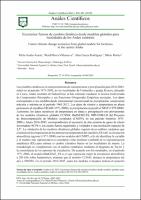Escenarios futuros de cambio climático desde modelos globales para localidades de los Andes centrales
Metadata
Show full item recordDate
2019Subject
Cambio Climático - Parámetro Meteorológico - Modelos y Simulación - Circulación Atmosférica - Andes - Modelos Climáticos Globales - Andes Centrales - Statistical Regionalization - Modelo GlobalCollections
Related Resource(s)
https://dialnet.unirioja.es/servlet/autor?codigo=5150248Abstract
Los posibles cambios en el comportamiento de la temperatura y precipitación para 2016-2045, relativos al período 1971-2000, en las localidades de Urubamba y granja Kcayra, ubicadas en Cusco, Andes centrales de Sudamérica, se han estimado mediante la técnica multivariada de Componentes Principales y sus Funciones Ortogonales Empíricas asociadas. Los datos
corresponden a los medidos desde instrumental convencional de precipitación, temperatura máxima y mínima en el período 1965-2012. Los datos de vientos y temperatura en altura pertenecen al reanálisis ERA40 (1971-2000), la precipitación regional a CMAP (1979-2000).
Asimismo, los datos numéricos de temperatura en altura y precipitación son provenientes de los modelos climáticos globales CCSM4, HadGEM2-ES, MPI-ESM-LR del Proyecto de Intercomparación de Modelos Acoplados (CMIP5), en sus periodo histórico 1971-2000 y futuro 2016-2045, correspondientes al escenario de alta emisión de gases de efecto invernadero RCP8.5, los cuales fueron registrados y validados a una resolución espacial de 2,5°. La validación de los modelos climáticos globales requirió de un análisis cuidadoso que consistió en la comparación de los patrones de temperatura del reanálisis ERA40, la circulación atmosférica regional (1971-2000) con los modelos del CMIP5, a fin de identificar la variable y el modelo más representativo a considerar como predictor confiable de la regionalización estadística (RE) para estimar el cambio climático futuro en las localidades de interés. La metodología se complementó con el análisis estadístico mediante el diagrama de Taylor y
la consistencia de los patrones de circulación. De acuerdo con los resultados, en el período 1971-2000, el modelo HadGEM2_ES es el que representa mejor la circulación atmosférica a 200 hPa sobre Sudamérica; mientras que el modelo CCSM4, destaca la temperatura del aire a 500 hPa. En el período 2016-2045, todos los modelos evaluados indican el aumento. The possible changes in the temperature and precipitation behavior for 2016-2045, relative to the 1971-2000 period, in the towns of Urubamba and granja Kcayra, located in Cusco, Central Andes of South America, have been estimated using the multivariated Principal Components
technique and its associated Empirical Orthogonal Functions. The data correspond to those measured from conventional precipitation instruments, maximum and minimum temperature in the period 1965-2012. Wind and temperature data at height belong to the ERA40 reanalysis (1971-2000), the regional rainfall to CMAP (1979-2000). Likewise, the numerical data of temperature in height and precipitation come from the global climatic models CCSM4, HadGEM2-ES, MPI-ESM-LR of the Comparison Project of Coupled Models (CMIP5),
in its historical period 1971-2000 and future 2016 -2045 corresponding to the scenario of high emission of RCP8.5 greenhouse gases, which were regillated and validated at a spatial resolution of 2.5°. The validation of the global climate models required a careful analysis that consisted in comparing the temperature patterns of the ERA40 reanalysis, the regional atmospheric circulation (1971-2000) with the CMIP5 models, in order to identify the
variable and the model more representative to consider as a reliable predictor of statistical regionalization (SR) to estimate future climate change in the localities of interest. The methodology was complemented by statistical analysis using the Taylor diagram and the consistency of circulation patterns. According to the results, in the period 1971-2000, the HadGEM2_ES model is the one that best represents the atmospheric circulation at 200 hPa
over South America; while the CCSM4 model highlights the air temperature at 500 hPa. In the 2016-2045 period, all the models evaluated indicate a temperature increase at 500 hPa. The results of the SR suggest that for 2016-2045 a warm-dry climate with an average increase in local temperature of 0.4 ° C and a 40% reduction in rainfall in SON, DEF and MAM, quarters corresponding to growth and development of rain fed potato and corn crops in Urubamba and Kcayra farm.
The following license files are associated with this item:








